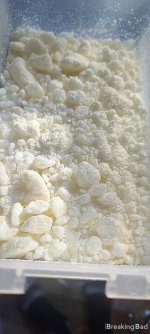Hi friends, I have preceded the reaction with 60 ml of 4 Methyl propiophenone and rational quantities of HBr and H2O2. however the RM remained red after using half the Qty of H2O2. I, then added the rest of H2O2 and later observed the formation of solids product. I let the RM to rest over night and observed green color in the next morning. I vacuum filtered the RM and got 36 g of product with green tint. i found some green liquid (about 40 ml) at the bottom of filter flask, under the aqueous phase. kindly guide me what the green liquid is, why it is formed, why I have got less product and where I was wrong when conducting the process. Thanks to all.
- Language
- 🇬🇧
- Joined
- Jan 15, 2023
- Messages
- 385
- Reaction score
- 199
- Points
- 43
Write the exact amounts of substances that were used in reaction, that is, for hydrogen peroxide, you need to specify the volume and its concentration, as well as for HBr acid. It is also important to know the reaction temperature and other conditions. The more precisely you write what you did, the more precisely you will receive the answer.
↑View previous replies…
Dear Bro, thanks a lot for kind response. I had used 60 ml of 4-Methylpropiophenone mixed with 46 ml of HBr (48 %). took 26 ml of H2O2 (35 %) and added drop wise. However, RM color remained red after adding about 15 ml of H2O2. Even then I had added the rest of per oxide. During initial addition of H2O2,temp. of RM raised too high that made hard to touch the flask, then it was controlled by putting ice cooled water around the flask. after some time, white fluffy solid formed and whole RM was allowed to rest whole night. next morning, green liquid (about 40 ml) was found with the solid product and this liquid was resting at bottom, means it was not soluble in aqueous solution. hopping this info will serve the purpose.
- Language
- 🇬🇧
- Joined
- Jan 15, 2023
- Messages
- 385
- Reaction score
- 199
- Points
- 43
Most likely, you ran out of free acid in the reaction and only had bromine, and the acid is known to be a bromination catalyst (stable enolization of the ketone is required throughout the entire bromination). I recommend using additional sulfuric acid to continuously enolize the ketone, the bromine color should disappear quickly during the reaction.
- Language
- 🇬🇧
- Joined
- Dec 22, 2024
- Messages
- 9
- Reaction score
- 1
- Points
- 3
Hey bro did you try again with higher acid quantity?
Have it solved the green stuff I tried also and had like green crystal after over night stirring...
Have it solved the green stuff I tried also and had like green crystal after over night stirring...

